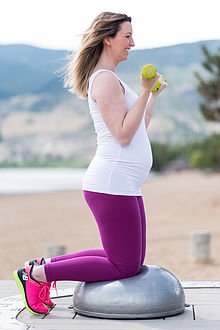Exhausted but elated, you’ve embarked on the wild journey of motherhood. As you navigate the whirlwind of new responsibilities, it’s only natural to desire a moment of respite – a chance to restore your body and rediscover the strength that brought new life into the world. However, lingering postpartum nausea may be hampering your eagerness to resume an exercise routine. Fret not, for this article unveils valuable insights and expert advice on how to exercise safely with postpartum nausea, ensuring that you can embrace the invigorating benefits of physical activity while prioritizing your well-being as a new mom. So grab a cup of soothing ginger tea and let’s embark on this transformative journey together.
Table of Contents
- Best Exercises for Postpartum Nausea: Gentle and Effective Ways to Stay Active
- Understanding the Causes and Triggers of Postpartum Nausea: Insights for Safe Exercise
- Preventing Postpartum Nausea During Exercise: Tips to Minimize Discomfort
- Guidelines for Safely Exercising with Postpartum Nausea: Expert Recommendations
- Key Considerations for Postpartum Nausea Management during Exercise
- Q&A
- To Conclude

Best Exercises for Postpartum Nausea: Gentle and Effective Ways to Stay Active
Recovering from pregnancy and childbirth can be a challenging journey, especially when dealing with postpartum nausea. While it is essential to listen to your body and take it easy during this time, staying active can help alleviate symptoms and improve your overall well-being. Here are some gentle and effective exercises to consider:
- Walking: A leisurely stroll in fresh air can do wonders for your physical and mental health. Start with short walks and gradually increase your distance and pace over time.
- Yoga: Practicing gentle yoga poses can help reduce postpartum nausea and promote relaxation. Choose poses that avoid straining your abdominal muscles, such as child’s pose, cat-cow, and gentle twists.
- Swimming: Taking a dip in the pool can provide a soothing relief and take away the pressure on your joints. Engage in low-impact water exercises to stay active without causing discomfort.
Remember, it’s crucial to consult with your healthcare provider before starting any exercise routine. They can provide personalized guidance based on your specific postpartum needs. Listen to your body, honor its limits, and focus on gentle movements that bring you joy and help alleviate postpartum nausea.

Understanding the Causes and Triggers of Postpartum Nausea: Insights for Safe Exercise
Pregnancy and childbirth can be both magical and overwhelming experiences, but for some new moms, they may come with unexpected side effects, such as postpartum nausea. This unpleasant symptom can make it challenging for women to engage in exercise and physical activities, which are essential for postpartum recovery and well-being.
Causes of Postpartum Nausea:
- Hormonal changes: Fluctuations in hormones, especially estrogen and progesterone, can contribute to feelings of nausea and discomfort after giving birth.
- Anesthesia and medications: Certain painkillers and anesthesia used during labor and delivery can cause postpartum nausea as a side effect.
- Morning sickness remnants: Women who had severe morning sickness during pregnancy may continue experiencing nausea after childbirth.
- Dehydration and low blood sugar levels: The physical demands of childbirth can lead to dehydration and low blood sugar levels, both of which can trigger nausea.
Triggers to Avoid:
- Fatty or greasy foods: These can be harder to digest and may exacerbate nausea symptoms. Opt for light, nutritious meals and snacks instead.
- Strong smells: Certain odors, such as perfumes, cooking smells, or cleaning products, can trigger or intensify postpartum nausea. Try to avoid strong-smelling environments.
- Excessive physical activity: While exercise is crucial for postpartum recovery, pushing yourself too hard can worsen nausea. Start with gentle and low-impact activities, gradually increasing intensity as you feel comfortable.
- Skipping meals: Empty stomachs can often make nausea worse. Try to eat small, frequent meals throughout the day to keep your blood sugar levels stable.
By understanding the causes and potential triggers of postpartum nausea, you can tailor your exercise routine to suit your needs and ensure a safe and enjoyable recovery. Remember to listen to your body, consult your healthcare provider if the symptoms persist, and most importantly, be kind and patient with yourself as you navigate this beautiful yet challenging phase of motherhood.

Preventing Postpartum Nausea During Exercise: Tips to Minimize Discomfort
Exercising after childbirth can be a wonderful way to regain strength and energy, but it’s important to listen to your body and take steps to prevent postpartum nausea. Here are some tips to help minimize discomfort and make your exercise routine more enjoyable:
- Stay hydrated: Drinking plenty of water before, during, and after your workout can help prevent nausea. Dehydration can worsen symptoms, so keep a water bottle handy and take regular sips.
- Choose the right time: Try to exercise when your stomach is relatively empty, such as before a meal or a few hours after eating. Exercising on a full stomach can increase the likelihood of experiencing nausea.
- Start slow and gradually increase intensity: If you’re new to postpartum exercise or have been inactive during pregnancy, it’s important to ease into your routine. Starting with low-impact exercises and gradually increasing intensity can help minimize the chances of feeling nauseous.
- Avoid intense movements: Certain types of exercises, like rapid twisting or jumping, may increase the likelihood of experiencing postpartum nausea. Opt for workouts that prioritize stability and balance, such as yoga or walking.
Remember, every woman’s postpartum journey is unique, so it’s essential to listen to your body and adapt your exercise routine accordingly. If you continue to experience persistent or severe nausea, it’s always best to consult with your healthcare provider for personalized advice and guidance.

Guidelines for Safely Exercising with Postpartum Nausea: Expert Recommendations
When experiencing postpartum nausea, it’s important to exercise with caution while taking your health into consideration. To help ensure safe and effective workouts, we have gathered expert recommendations to guide you along the way. Here are some guidelines to keep in mind:
- Listen to your body: Pay close attention to what your body is telling you during workouts. If you feel any discomfort or worsening of symptoms, it’s important to stop immediately.
- Start slowly: Begin with low-impact exercises such as walking or gentle stretching. Gradually increase the intensity and duration of your workouts as you feel more comfortable.
- Stay hydrated: Dehydration can make nausea worse, so make sure to drink plenty of water before, during, and after exercising. Sipping on fluids throughout the day can also help prevent nausea from exacerbating.
- Choose the right time: Opt for exercising when you typically experience less nausea. This might be in the morning before breakfast or in the evening after your last meal. Experiment with different times to find what works best for you.
- Modify your exercises: If certain movements or positions trigger your nausea, modify or avoid them. For example, if bending forward makes you feel queasy, try sitting or standing upright during your workouts.
- Consider professional guidance: Consulting with a healthcare professional or a certified postpartum exercise specialist can provide you with personalized advice and exercises tailored to your specific needs.
Remember, the journey to postpartum recovery is unique to every individual, and what works for one person may not work for another. Prioritize your well-being, and always consult with your healthcare provider before starting any exercise regimen.
Key Considerations for Postpartum Nausea Management during Exercise
When it comes to managing postpartum nausea during exercise, there are several key considerations to keep in mind. These guidelines can help ensure a safe and enjoyable fitness routine for new moms.
Listen to Your Body
During postpartum exercise, it’s crucial to pay close attention to your body’s signals. If you begin to feel nauseous or lightheaded, it’s important to take a break and rest. Pushing through discomfort can potentially lead to unnecessary strain or injury. Remember, your body is still recovering, so it’s essential to be patient and give yourself time to heal.
Choose the Right Time
Timing is everything when it comes to managing postpartum nausea. Opt for exercise sessions that align with your body’s natural rhythms, such as when you feel most energized. Additionally, try to avoid working out immediately after a meal, as this can contribute to feelings of queasiness. It’s best to wait at least an hour after eating before engaging in any physical activity.
Hydrate, Hydrate, Hydrate
Staying properly hydrated is crucial for overall health, especially during postpartum exercise. Dehydration can often exacerbate feelings of nausea, so be sure to drink plenty of water before, during, and after your workout. Keeping a water bottle nearby and sipping regularly can help prevent discomfort and ensure your body stays properly fueled.
Modify Intensity
Adjusting the intensity of your workouts to a level that feels comfortable is vital for managing postpartum nausea. Start with low-impact activities and gradually increase intensity as you regain strength and endurance. Always remember to warm up properly and include cool-down stretches to avoid sudden spikes in heart rate that may trigger feelings of queasiness.
Seek Professional Advice
If postpartum nausea persists or worsens during exercise, it’s essential to consult with a healthcare professional. They can assess your specific situation and offer tailored advice to address any potential underlying issues. Remember, every woman’s postpartum journey is unique, and seeking guidance from a medical expert ensures you receive appropriate care and support.
Q&A
1. Can exercise help with postpartum nausea?
Exercise can help alleviate symptoms of postpartum nausea by increasing blood flow and releasing endorphins. However, it is important to start with light exercises and listen to your body’s cues.
2. What are some safe exercises to do while experiencing postpartum nausea?
Gentle exercises such as walking, yoga, and swimming are generally safe and can be beneficial for postpartum nausea. It’s important to start slowly and ensure proper hydration throughout the exercise routine.
3. Should I modify my exercise routine if I experience postpartum nausea?
Yes, it is crucial to modify your exercise routine if you’re experiencing postpartum nausea. Consider reducing the intensity and duration of your workouts, take breaks when needed, and focus on exercises that promote relaxation and flexibility.
4. Are there any exercises that should be avoided altogether?
While every individual is different, high-intensity exercises, vigorous jumping movements, and any exercises that exacerbate your nausea should generally be avoided. It’s important to listen to your body and seek guidance from a healthcare professional.
5. How can I prevent postpartum nausea during exercise?
To prevent postpartum nausea during exercise, it’s essential to eat a light meal or snack before exercising and stay hydrated throughout. Additionally, avoiding exercises immediately after eating and maintaining proper posture during workouts can help minimize nausea.
6. Is it safe to exercise alone with postpartum nausea?
While it is generally safe to exercise alone with postpartum nausea, it’s recommended to inform someone close to you about your exercise routine and have a way to contact them in case you need assistance. Consider exercising in well-lit areas and carrying a cellphone for added security.
7. Can I still exercise if my postpartum nausea becomes severe?
If your postpartum nausea becomes severe or is accompanied by other concerning symptoms, it is important to pause your exercise routine and consult with a healthcare professional. They can provide proper guidance and determine the best course of action.
8. How long should I wait after a meal before exercising with postpartum nausea?
Waiting approximately 1 to 2 hours after a meal before exercising with postpartum nausea can help prevent further discomfort. However, it’s important to listen to your body and adjust the waiting time based on how you feel individually.
9. Are there any warning signs that I should pay attention to during exercise with postpartum nausea?
While exercising with postpartum nausea, pay attention to warning signs such as dizziness, lightheadedness, severe stomach pain, or fainting. If you experience any of these symptoms, stop exercising immediately and seek medical attention.
To Conclude
As we bid adieu to this guide on exercising safely with postpartum nausea, always remember that your body deserves utmost care and attention during this delicate phase. Embrace the journey of motherhood, but don’t forget to prioritize your own well-being in the process.
While nausea may have tried to dampen your spirits, armed with these smart exercise tips, you can conquer it like the warrior that you are. So, go forth and reclaim your strength, one gentle rep at a time.
Remember, dear reader, that every woman’s postpartum experience is unique. Listen to your body’s whispers and seek professional guidance whenever necessary. Take small steps towards your fitness goals and cherish the gradual progress you make.
As you embark on this journey towards physical and mental rejuvenation, find solace in knowing that you are not alone. Lean on your support network and connect with fellow mothers who have walked a similar path. Their experiences, insights, and even laughter will lift your spirits when the road seems daunting.
With patience, dedication, and self-compassion, you’ll soon find yourself surpassing previous limits and embracing newfound resilience. Through every stretch, every warm-up, and every cooldown, remember to honor the incredible strength that your body possesses.
So, dear reader, as you conclude this article and step into the exciting realm of postpartum exercise, let your inner strength guide you to a place of harmony and wellbeing. You deserve it, and so does the beautiful life you’ve brought into this world.
Farewell, and may your journey towards postpartum fitness be rewarding, fulfilling, and above all, safe.
As an affiliate, my content may feature links to products I personally use and recommend. By taking action, like subscribing or making a purchase, you’ll be supporting my work and fueling my taco cravings at the same time. Win-win, right?
Want to read more? Check out our Affiliate Disclosure page.